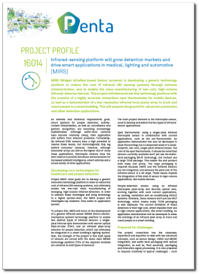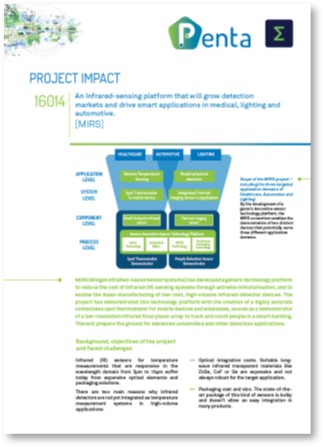Call :
PENTA Call 1
Project status :
Completed
Key application areas
 Transport & Smart Mobility
Transport & Smart Mobility  Health & Well-Being
Health & Well-Being  Digital Life
Digital Life Essential capabilities
 Systems and Components Architecture, Design & Integration
Systems and Components Architecture, Design & Integration  Safety, Security & Reliability
Safety, Security & Reliability  Computing & Storage
Computing & Storage  ECS Process Technology, Equipment, Materials & Manufacturing
ECS Process Technology, Equipment, Materials & Manufacturing
PARTNER
Fraunhofer-Gesellschaft zur Förderung der angewandten Forschung e.V. / Melexis NV / University of Kiel / X-FAB MEMS Foundry GmbH / X-FAB MEMS Foundry Itzehoe GmbH / aixACCT Systems GmbH
Fraunhofer-Gesellschaft zur Förderung der angewandten Forschung e.V. / Melexis NV / University of Kiel / X-FAB MEMS Foundry GmbH / X-FAB MEMS Foundry Itzehoe GmbH / aixACCT Systems GmbH
Countries involved
 Germany
Germany  Belgium
Belgium Project leader(s)
Carl Van BuggenhoutKey project dates
01 May 2017 - 30 April 2020Infrared-sensing platform will grow detection markets and drive smart applications in medical, lighting and automotive

MIRS (Midget InfraRed-based Sensor systems) has developed a generic technology platform to reduce the cost of infrared (IR) sensing systems through extreme miniaturisation, and to enable the mass-manufacturing of low-cost, high-volume infrared-detector devices. The project has demonstrated this technology platform with the creation of a highly accurate contactless spot thermometer for mobile devices and wearables, as well as a demonstrator of a low-resolution infrared focal plane-array to track and count people in a smart building. This will prepare the ground for advanced automotive and other detection applications
Background, objectives of the project and faced challenges
Infrared (IR) sensors for temperature measurements that are responsive in the wavelength domain from 3µm to 15µm suffer today from expensive optical elements and packaging solutions.
There are two main reasons why infrared detectors are not yet integrated as temperature measurement systems in high-volume applications:
• Optical integration costs. Suitable long-wave infrared transparent materials like ZnSe, CaF or Ge are expensive and not always robust for the target application.
• Packaging cost and size. The state-of-the-art package of this kind of sensors is bulky and doesn’t allow an easy integration in many products.
The primary goal of the MIRS project was to develop a generic innovative technology platform in order to reduce the cost of the IR sensing systems by extreme miniaturization, with the final objective to enable low-cost mass manufacturing for emerging high volume infrared detector markets.
The challenges lay in the process integration of the key technology building blocks that were envisioned in this project, such as: the deep vacuum wafer-level bonding of cap wafers to monolithically integrated MEMS-CMOS silicon wafers; the integration of a novel optical silicon lens technology with cap wafers; the integration of pyroelectric elements on MEMS-CMOS silicon wafers; and the compatibility of Through-Silicon Vias (TSVs) into permanently cap-bonded monolithically integrated MEMS-CMOS silicon wafers.
Technological achievements
Within the MIRS project, 4 key technological innovations have been achieved.
The first key innovation relates to the technology required to manufacture infrared sensors. Due to the nature of the infrared sensor as a micro-electro-mechanical system (MEMS) sensor, it must be embedded in a hermetic housing, with a low pressure inside that housing, in order to maximize the sensitivity of the sensor. To achieve the lowest-cost manufacturing technology, that hermetic housing with low pressure is created on the wafer-level, whereby a silicon cap wafer is hermetically bonded to a silicon sensor-CMOS wafer. MIRS-partner XFAB has demonstrated a major improvement of the Technology Readiness Level (TRL) of their hermetic wafer-level bonding technology which enabled to create demonstrators on the product-level by MIRS-partner Melexis.

The second key innovation concerns the integration of Through-Silicon Vias (TSVs) inside permanently bonded infared sensor wafers, with the goal to create infrared sensor systems with a reduced footprint by enabling chip-scale packages. MIRS-partner X-FAB MEMS Foundry GmbH (XMF) has advanced their TRL to demonstrate a wafer-level feasibility of integrated TSVs inside infrared sensor wafers with permanently bonded cap wafers.
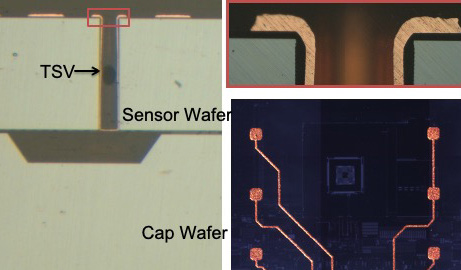
For the third key technology innovation, MIRS-partner ISIT has developed a patented approach to integrate high-end silicon planoconvex lenses inside cap wafers by using silicon balls with a pre-sorted Radius-of-Curvature (ROC). A video that shows the fabrication and demonstration is available on public platforms: https://www.youtube.com/watch?v=lXm9ALz89Qc
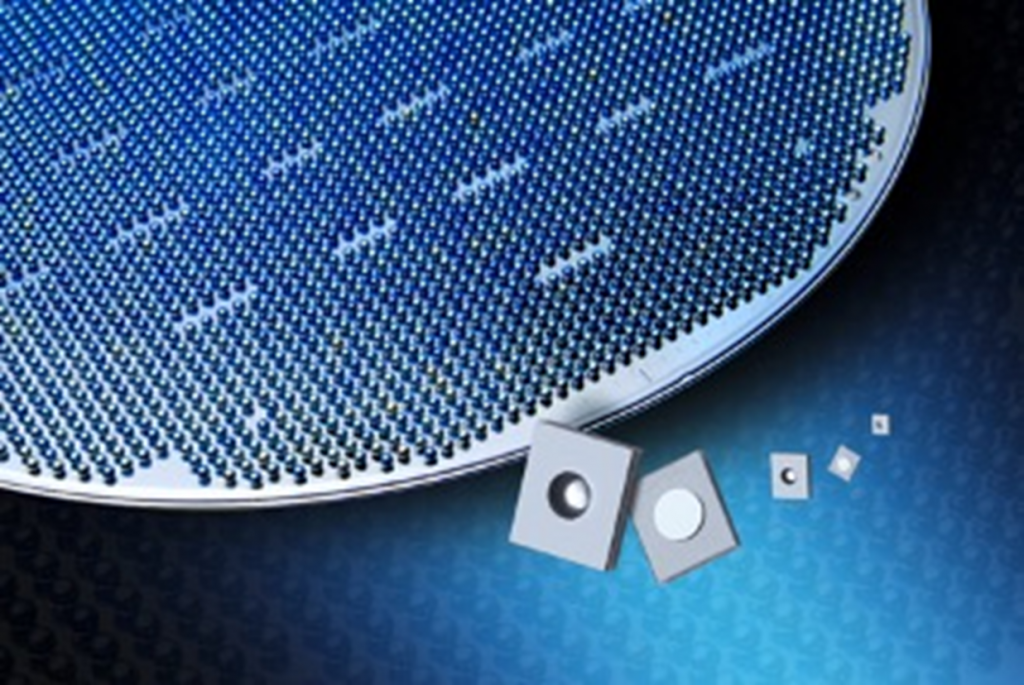
Within the fourth key technology innovation pillar of the MIRS project, MIRS-partners ISIT and University of Kiel (CAU) have integrated AlScN pyroelectric elements on a CMOS-MEMS wafer. MIRS-partner aixACCT has developed a laser-based measurement tool in order to characterize those AlScN layers, which was successfully used to assess the performance of the AlScN pyroelectric elements that were integrated on the CMOS-MEMS wafer in the project.

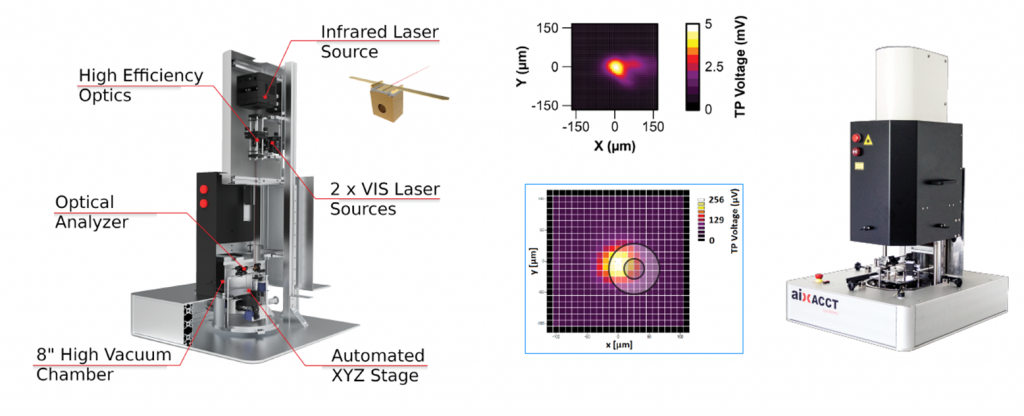
Copyright: aixACCT
Market Potential
With the core technology advancements that had been reached in the project, the complete MIRS consortium built two important demonstrators: a contactless single-pixel IR temperature sensor as well as a multi-pixel IR detector. The high-sensitivity single-pixel IR temperature sensor can be combined with the innovative lens approach to result in a sensor with a narrow optical Field of View (FOV) which enables contactless fever thermometer applications without the need to approach the sensor close to the target person. This enables the device-maker Melexis to approach multiple markets in the mobile health domain, like fever thermometers as well as mobile devices for continuous health monitoring, such as smart watches, sports watches and medical wearable devices.
The multi-pixel IR array detector has large potential in fever screening access control applications – which is a booming COVID19-driven market, but also serves emerging markets like people detection applications for smart buildings. Lower-cost systems could drive up the volumes from high to mid-end systems in Heating, Ventilation and Air-Conditioning (HVAC) applications, in which Melexis has further enhanced its position. Also, other small appliances and industrial applications, such as cook top safety monitoring, electrical cabinets safety monitoring or production parameters monitoring (e.g. for 3D-printer materials) are expected to see a further growth, albeit not as fast as for the consumer, medical and smart building markets.
Last but not least, the automotive trends of electrification, personalization and autonomous driving requires IR temperature sensors for better personalized thermal comfort inside the car, for driver/passenger monitoring to detect (e.g. occupancy, potentially nausea, drowsiness and others). Device-maker Melexis has an excellent position as one of the key suppliers to the automotive market with an average of 11 Melexis chips in every new car.

Societal & Economic Impact
The societal impact of IR temperature sensors can be split into two domains. The first domain comprises contactless body-core thermometers with medical accuracy for healthcare applications (like fever thermometers). The current COVID19 pandemic has massively boosted the need for contactless thermometers in medical wearable devices, which requires these IR temperature sensors to be small, lightweight and low-cost – yet very accurate – in order to determine a person’s body-core temperature. Within the MIRS project, the team has focused on miniaturizing IR temperature sensors with these objectives, and they have successfully created a demonstrator of such an IR temperature sensor.
The second domain of interest is attributed to a growing market of smart systems for people detection, activity context interpretation, surveillance and gesture recognition – which all are becoming increasingly sophisticated. Although standard cameras have become relatively cheap, their application still suffers from two major problems. Above all, privacy concerns of people feeling observed need to be seen as a social requirement that technologists have to fulfil. Secondly, the need for external light with CMOS/CCD imagers is often an unresolvable problem. IR detectors don’t require external light because all objects emit IR radiation, which can be detected with these IR detectors. This kind of IR detectors can only detect but not recognize people because they only measure differences in temperature. As such, IR detectors have a high potential to resolve these issues. The MIRS demonstrator of an IR detector also prepares the ground for advanced automotive scene detection in assisted or autonomous driving.
Patents/Standardisation/ Publications
Throughout the execution of the project, the university of Kiel (CAU) has discovered ferroelectricity in AlScN – which to the best knowledge of the MIRS team hadn’t been reported upfront – and which could enable novel microelectronic applications. The Fraunhofer-Institute for Silicon Technology in Itzehoe (ISIT) has been granted a patent on their novel method of integrating silicon optical lenses in cap wafers, which can be wafer-bonded to IR sensor-CMOS wafers. That achievement enables them to further develop their technology, which has the potential to drastically reduce the cost of infrared silicon optics. In the MIRS project patent applications have been generated by XMF which are now being assessed by the patent offices. Besides, also many technical papers have been published and presentations have been given on the key technology building blocks which were scoped in the project.
Future Developments
The MIRS project delivered very exciting results, which will be exploited by further advancing these innovative technologies, towards achieving a Technology Readiness Level (TRL) that enables mass production of new improved products. The Christian-Albrechts-University of Kiel (CAU) has decided to continue their explorative work on ferroelectricity of AlScN with the aim to enable novel microelectronics applications, and the measurement tool of aixACCT will be further extended to other applications.

the room, but they can’t be identified, which resolves the privacy concern of standard cameras. Copyright Melexis

